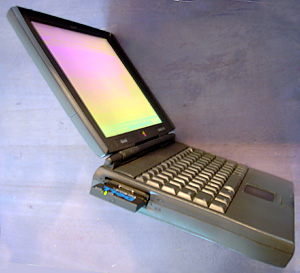Above: The first Apple laptop to feature a lithium-ion battery was the PowerBook 1400, introduced in 1996. This was a significant move as lithium-ion batteries offered better energy density and a longer lifespan compared to the nickel-cadmium and nickel-metal hydride batteries used in earlier laptop models. Decades later, lithium-ion still dominates most of our battery-powered devices, even as other areas of technology have taken giant leaps forward, as Will Trafford explains. Photo / Derek K. Miller
In the remote beauty of our island, daily life hinges more on battery technology than perhaps anywhere else in New Zealand, and perhaps the developed world. Relying on solar and wind power, the efficiency and capability of our batteries are not just conveniences; they are essentials. Yet, surprisingly, the last major advancement in battery technology was the commercialization of lithium-ion batteries, which rose to prominence in old-school, brick-like 1990s laptops over three decades ago.
The promises of tech moguls like Elon Musk, heralding a new era of battery technology, have repeatedly fallen short, leaving us with the same old lithium-ion technology dressed in new garb. Instead of true innovation, we’ve witnessed tech and automotive companies pushing the limits of existing batteries, cramming in as much charge as possible for the sake of faster charging times. This approach often comes at a steep price: the longevity and overall health of the battery itself.
In the past three decades, the internet has revolutionized our world, fundamentally altering how we live, work, and connect. So why hasn’t battery technology kept pace with such transformative change? The answer lies in the nature of the beast. Developing groundbreaking battery technology requires centralized, high-level research and development, often necessitating advanced degrees in physics and chemistry. Unlike the democratized realm of app development, where a single inspired idea can lead to global change, battery innovation is mired in complex, collaborative challenges, often hindered by commercial interests unwilling to work together. This landscape has led to a more cautious and slower pace of advancement.
But there is hope on the horizon. Here are five technologies that stand a real chance of materially impacting our energy storage solutions, moving us beyond the realm of science fiction:
- Solid-State Batteries: These batteries promise a safer and potentially more energy-dense alternative to lithium-ion. By replacing the liquid electrolyte with a solid, they reduce the risk of fire and can operate more effectively in extreme temperatures. Hyped as a breakthrough, these batteries face real-world challenges in material durability and mass production, making them a distant solution rather than an immediate relief.
- Lithium-Sulfur Batteries: Boasting a higher theoretical energy density, these batteries could drastically increase the range of electric vehicles. Despite their potential for higher energy density, the current (hehe) issue is these batteries suffer from rapid degradation, rendering them impractical for long-term use.
- Graphene Batteries: Leveraging graphene’s superior conductivity, these batteries could charge much faster than traditional lithium-ion batteries and potentially offer greater capacity. Some estimates suggest that graphene could enable batteries to charge up to five times faster than current lithium-ion batteries.The primary obstacle is the cost-effective production of graphene at a scale large enough for widespread battery manufacturing.
- Flow Batteries: Particularly suited for stationary energy storage, flow batteries store energy in liquid electrolytes. They excel in scalability and have longer lifespans than conventional batteries. Their suitability for large-scale energy storage does little to address the needs of smaller, portable applications, making them a partial solution at best. But for people really willing to fork out big bucks on the motu, this tech is pretty gamechanging.
- Sodium-ion Batteries: As an abundant and cheaper alternative to lithium, sodium-ion batteries present an attractive option for sustainable energy storage. The abundance and lower cost of sodium are offset by the struggle to achieve the energy density and efficiency of lithium-ion batteries.
On our island, the reality is harsh but clear: we are far from seeing a transformative change in battery technology. The much-touted advancements are either on the distant horizon or compromised by the realities of cost, scalability, and material limitations. For now, we continue to rely on our solar panels and wind turbines, bound by the limitations of current battery technology, that doesn’t mean there’s no hope though. Where there’s money to be made, innovation is bound to follow.







